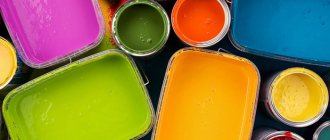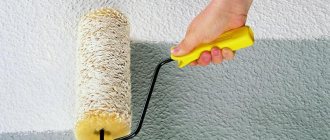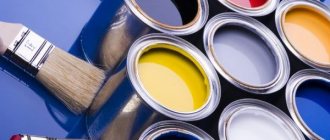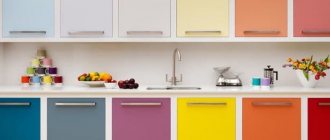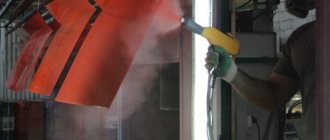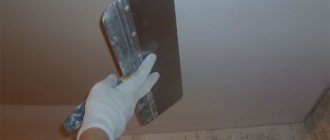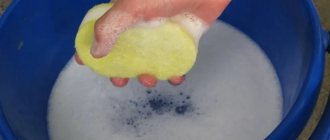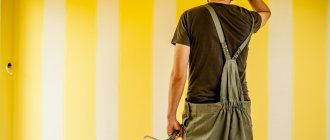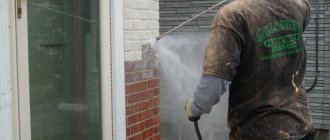Modern decorative materials are used to make design projects of any complexity. Proper selection of the composition and compliance with the recommendations will help to renovate the apartment. Advantages of these paints:
- The service life of coatings made using dyes is at least 10 years.
- Unlike wallpaper, the surface decorated with paints and varnishes is reliably protected from fading by a UV filter.
- A painted wall is not afraid of pet claws, fungal mold, or mechanical stress.
- Dirt and dust are easily washed off.
- Water-dispersed LCS are hypoallergenic and environmentally friendly.
Mosaic as an alternative to wallpaper
The mosaic composition can consist of glass, smalt, ceramic tiles or natural stone.
Metal, mirror, and gold mosaics are less common. Most often used in the kitchen or bathroom. The material is not cheap, but beautiful and durable. A great alternative to wallpaper when decorating a room in a medieval style. The amazing versatility of the mosaic will successfully fit it into an ethnic or vintage style, retro interior or Moroccan effects. You can decorate a living room or bathroom with multi-colored mosaics, place it on the kitchen apron or in the floor covering.
Preparing the walls
It's no secret that walls need to be prepared regardless of the type of finishing. But it is worth saying that in the case of painting, the walls need to be prepared in the best possible way. Often it is the smoothness and evenness of the walls that is the formula for success. All imperfections are visible under the paint, so inspect the walls carefully.
- Plaster. The walls must be plastered, creating a base for puttying work.
- Putty. The walls are puttyed with a thin layer, after which they are cleaned to a smooth state.
- Primer. All gaps between plaster, putty and finishing must be primed. The primer provides good adhesion of materials.
Important Rules
1. If you decide to play with contrast, then combine those colors that fit perfectly together.
2. Before applying a design to the entire surface or combining paints, test on a small surface or paper. Once you are sure that everything is working out perfectly, get to work.
3. Protect sockets, switches, baseboards and floors from paint. That is, those elements that you do not plan to paint.
4. Adhesive paint is used only in a warm form and is applied in no more than two layers. If you increase the number of layers, the paint will peel off.
5. To create a relief, use adhesive or glazed paint. You can work with such paints only after complete drying (it dries for seven days).
Decorative paint application technology
Decorative paint itself can be applied with a regular roller, thereby creating a beautiful, even layer, but there are many different technologies.
For example, silk paint should be applied this way:
- apply the first layer of paint;
- after it dries with a sponge, apply a second layer of paint;
- After 20 minutes, the layer is smoothed in different directions with a spatula.
The option of applying decorative paint depends solely on what effect you want to get at the end. For the sandy effect, the second layer of paint is seemingly rubbed into the walls, but for the metal effect the technology is completely different.
If you decide to create an interesting decor in your apartment and use decorative paint for this, then read more about the technology for applying a particular effect.
Which is better: painting walls or wallpaper?
When choosing between wallpaper and paint, the question naturally arises: which is better. There is no clear answer to this. Both wallpaper and paint have pros and cons. For example, paint is easier to apply, but it requires more careful preparation of the wall. Wallpaper is more difficult to glue, but it takes less time to prepare the wall. The use of paint allows you to experiment with colors and patterns, while with wallpaper the choice is limited to what is presented in the store.
Wall paint is very easy to apply; all you need to do is take a roller, spatula or sponge. Also, with their help you can achieve different patterns and textures.
To paint the wall, it is best to use matte paint, as it will be able to hide all the small irregularities. If the choice falls on glossy paint, you need to spend a lot of time leveling the wall. Glossy paint enhances any imperfections or unevenness.
The advantage of decorative paint is the absence of an unpleasant odor. Professional decorative paint can change its color like a chameleon. A wall painted with decorative paint can be wet cleaned.
There are several types of decorative paint: paint, plaster and coating. The plaster itself can be thin-layered and embossed. Using relief plaster you can achieve a beautiful textured finish.
To obtain a decorative effect, paint can be mixed with decorative plaster.
Wall painting process
In order for the wall to acquire the desired design, you need to prepare the wall in three steps:
- Apply the first layer - primer, which will level and remove dust from the surface of the wall;
- Apply a second coat of primer paint;
- Apply a decorative layer with a special roller or spatula, which will create the desired effect.
These actions can be done independently, without the help of specialists. The main thing is to carefully study the procedure and strictly follow it.
Painting and pasting walls – which is more reliable and cheaper?
No one can decide to paint walls or glue wallpaper except the owner of a residential property. It is the owners who have to choose suitable facing materials, and in order to guarantee high quality finishing, its durability and attractiveness, the choice must be made consciously, comparing the technical and visual advantages of these types of wall decoration.
The advantage of painting walls is the ability to experiment with colors
Unfortunately, it is impossible to say unequivocally what is better: wallpaper or painting the walls. Both of these finishing products have both positive and negative features. The most important characteristics of wall finishing with paint include:
- Easy installation. It is much easier to cover walls with paint than with wallpaper; such work will not cause difficulties even for people who have never had to carry out cosmetic repairs before.
- The need for preliminary preparation of the wall. Paint and varnish coatings can only be used on perfectly smooth surfaces that do not have significant imperfections, chips or cracks.
- Opportunity to experiment with colors. You can paint a wall with paints of various shades, and the owner can use several colors at once, creating compositions that correspond to the purpose of the room and the tastes of its future users. There are glossy, matte paints and textured enamels on the market, which further expand the possibilities of decorating rooms.
- Permissibility of wet cleaning of painted walls. After painting, walls can be washed using a soap solution and special detergents to keep the surfaces clean and attractive.
As for wallpaper, they require much more complex installation work. Pasting the wallpaper must be done carefully and carefully, using special adhesives and certain professional knowledge that can help the owner independently cover the most difficult areas of the wall, for example, external and internal corners. Although wallpaper is more difficult to glue, this material places significantly fewer demands on the quality of the surfaces being designed.
There is a wide range of wallpapers on the market, but their choice is always limited, unlike paints and varnishes. Paper canvases do not provide the same breadth of possibilities for individualizing the interior, for decorating rooms in accordance with the unique desires, ideas and requirements of future users. On the other hand, modern wallpapers themselves are very attractive and with their help you can make any room of any size beautiful.
When deciding what is better, painting the walls of a house or hanging wallpaper, people always pay attention to the cost of facing materials. If the price of cladding is the most important factor for the owner, then he should choose paint. Paint and varnish materials are very affordable; they allow you to cover any room with minimal investment. If price is not an important factor for you and wallpaper seems more aesthetically pleasing than decorative paint, purchase and stick non-woven or fabric materials on the walls.
Using cork backing
This material is used quite often as a covering on walls instead of wallpaper. Cork backing looks beautiful and is versatile, making it easy to decorate walls.
Its use is due to the fact that it becomes possible to quickly and with good quality level the wall surface. The panels have high performance characteristics, withstand significant loads, and are environmentally safe. They are used for finishing premises for various purposes and do not cause harm to the human body. A variety of textures and colors allows you to uniquely decorate a room.
Mosaic paint
What can be applied to the walls instead of wallpaper? Pay attention to the coloring composition, for the production of which acrylic copolymers and multicolor microgranules are used. Small capsules that fall on the wall rupture, forming beautiful unusual spots on the surface
The advantages include:
- originality of decor;
- resistance to temperature changes and the negative effects of a humid environment;
- ease of cleaning;
- long service life;
- vapor permeability;
- environmental Safety.
Unfortunately, the choice of color options for this material is limited.
Textured paint
How else can you decorate the walls in a room besides wallpaper? Use a textured composition that allows you to create unusual patterns.
The material is quite dense and has a viscosity, but is applied in a thinner layer than a textured plaster mixture. It is resistant to water, does not absorb odors, prevents the appearance of mold, does not cause allergenic symptoms, easily tolerates changes in temperature, does not change shade under the influence of ultraviolet radiation, provides walls with the ability to “breathe”, and masks small flaws in the wall surface.
Working with such decorative material requires appropriate skills and careful preparation of the walls.
Wall frescoes
This is another answer to the question, “how to decorate the walls in a room other than wallpaper?” It turns out that frescoes are made not only on a wet plaster layer - in the construction industry there are other options on a similar theme, the most popular of which are frescoes on a non-woven or canvas backing. The main differences are high-quality photo printing, the ability to produce custom-made material, and the flexibility of the substrate, allowing installation on various surfaces.
Flexible Sandstone
Instead of wallpaper, it is possible to make such a finish. Sandstone made by imprinting consists of grains of sand glued with acrylic glue onto a fabric surface and recreating the naturalness of the design.
The production is available in two versions - in the form of rolls or sheets, and which of them is better to stick is up to everyone to decide for themselves. Sandstone is flexible, the impressions come out different - dark, lightish, with veins.
The finishing material is characterized by a long service life, environmental safety for the human body, aesthetic appearance, resistance to water and temperature changes, and ease of installation.
There is also a significant drawback associated with the high cost of material for wall decoration.
Flexible slate
What else can you do instead of wallpaper on the wall? Note the ultra-thin natural slate applied to a polymer base. Sheet elements are distinguished by special patterns and textures, eliminating repetition
Slate is flexible but durable.
It is not susceptible to temperature changes and exposure to a humid environment, is easy to cut, quickly installed, does not harm the human body, and will last a long period.
Unfortunately, the material is expensive and leaves seams after installation.
Considering water-based paints
When deciding what to paint the walls of an apartment with instead of wallpaper, there is only one correct answer. This is paint. Among all the materials in this group, water-based paint is the most popular. It is odorless, dries quickly and is absolutely harmless to people.
Water-based paint is divided into three groups:
- water-based;
- water-dispersible silicone;
- water-dispersed acrylic based.
Let's look at each type in more detail.
Water-based paint
The most popular paint among all is water-based paint. This paint and varnish product is made on the basis of polyvinyl acetate. The main advantage is that the paint dries quickly and lays down in an even layer.
If you are going out to paint the walls a specific color, two coats are enough.
Water-based paint has a beneficial effect on the walls of a living space. Many experts say that with this coating the walls “breathe”. Perfect for rooms with asthmatics, allergy sufferers and small children.
Disadvantages of water-based paint:
- Walls intended for this type of coating must be perfectly smooth, since water-based products do not paint over imperfections.
- The coating can be easily washed with a wet cloth. If you drag over the wall several times, you will be left with a mark that will need to be painted over.
- This coating on the walls is quite easy to damage by any mechanical means. The scratch becomes very noticeable.
- During use, abrasions occur in the most popular places, which it is advisable to constantly paint over.
Water-dispersed silicone paint
An excellent option for painting the walls in an apartment instead of wallpaper is a water-dispersion mixture. We can say with confidence that this product is perfect.
Advantages of water-dispersion paint for the house:
- Easy to apply to any surface.
- Does not require preliminary preparation of walls and a perfectly flat concrete or plasterboard base.
- Covers cracks up to two millimeters deep and wide.
- Due to the film formed after application, it is not afraid of moisture, mechanical damage, and does not collect dust.
- Can be washed.
- Does not lose its color during the entire service life.
- Useful for walls.
- Can be used in rooms with high outdoor humidity.
- Has no odors.
Acrylic water-dispersion paint
If you are thinking about what paint to paint the walls in your apartment instead of wallpaper, then you should consider purchasing acrylic water-dispersion paint. According to its distinctive characteristics, it is something between a similar silicone-based product and simply a water-based liquid.
According to its quality characteristics, it is more suitable for silicone-based water-dispersion paint:
- dries quickly;
- has no pungent odors;
- easy to apply.
Acrylic-based water-dispersion paint is in greatest demand among buyers, since the price-quality ratio is at an average level. If you want to make inexpensive home renovations, but at the same time of excellent quality, then opt for this paint and varnish product.
Choosing paint for the corridor, bathroom and kitchen
For decorating walls in the hallway and kitchen, paints that are made on the basis of acrylic with the addition of water-based silicone are suitable. This is due to the fact that they are highly resistant to stains and can be washed frequently. At the same time, the original shade does not change at all.
It is recommended to use textured paints in the kitchen, as it will be difficult for you to keep this part of the house clean.
How to paint walls - types of materials
The modern market offers customers a huge selection of paints and varnishes, and before choosing a finishing color to paint the walls in an apartment or house instead of wallpaper, you need to understand what kind of paints there are. Based on their chemical composition, the following types of enamels are distinguished:
- emulsion;
- alkyd;
- adhesive;
- silicate.
Emulsion paints are the most extensive and widespread group of paints, most often used to decorate residential buildings inside and outside. Such materials are characterized by fast drying, do not have an unpleasant odor, and are resistant to a variety of adverse influences. A very popular type of emulsion finishes are water-based or water-dispersed paints. They have strong adhesion to various surfaces and durability.
The advantage of water-dispersed compositions is their resistance to environments with high humidity
Water-dispersed compositions are very resistant to environments with high humidity, which is why they are often used when finishing walls and other surfaces in “wet” areas of residential buildings. Thanks to the huge range, they can be used to create complex interiors using different colors and creating patterns. Some types of such emulsions even allow you to create three-dimensional drawings.
The second type of emulsion compositions is acrylic paints. Acrylic resins act as a binding element, thanks to which the enamels are characterized by high elasticity, necessary for working with various surfaces to be coated. Acrylic enamels are less demanding on the quality of walls than water-based enamels; they can be used to paint surfaces with minor cracks.
After drying, acrylic compositions become frost-resistant and moisture-resistant, but they are not recommended for use on damp walls.
The third type of emulsion materials is latex paints, which are quite expensive. Such compositions, despite their high cost, are very often used in everyday life, since they are characterized by unsurpassed waterproofing parameters. Latex paints can be used to paint walls that have minor chips and cracks up to 1 mm thick. They allow you to reliably cover concrete, brick, and plasterboard walls, dry quickly and do not have an unpleasant odor.
Silicone emulsions are created from emulsified silicone resin, thanks to which the paint has water-repellent properties and creates an elastic film after drying. A wall painted with silicone emulsion will not let in not only water, but also air.
Alkyd paints are also quite popular on the market. They are made from alkyd resin and are often used to decorate wood, metal, plaster walls and interior elements. All alkyd paints presented in stores are waterproof and environmentally friendly; they do not have a negative impact on human health. There are two types of alkyd cladding:
- oil;
- enamel.
Silicate finishes contain liquid glass, thanks to which they have high vapor and air permeability characteristics. They withstand even very unfavorable operating conditions and severe temperature changes. They are not used for finishing previously painted surfaces.
Adhesive facing compositions are made from organic polymers diluted in water; their technical characteristics are almost identical to emulsion dyes, but do not have the same resistance to moisture.
How can you decorate a corridor instead of wallpaper to create an exquisite design in an apartment?
Many people are interested in what can be used to replace wallpaper when decorating a corridor to make it look more spacious and interesting. When decorating a corridor, you need to correctly select the shade and texture of materials.
When selecting finishing materials for the corridor, you need to use durable and stable finishing materials that can be cleaned without any problems
This is very important, because it is in the corridor that the largest amount of pollution from the street accumulates
Wall panels are perfect for decorating a corridor; they look quite elegant and unique. Provided they are placed horizontally, you can achieve a visual enlargement of the room.
Wall decoration options
In the process of decorating your office, you should pay attention to its decorative features. First of all, make sure that the wallpaper for the walls has a suitable surface
In cramped rooms, you can use wallpaper with a glossy effect, which, by reflecting light, will expand the space. Matte wallpaper is suitable for work areas: here you should not be distracted by either shades or textures.
Wallpaper with sparkles, shimmer, spectacular inserts or gilding are used quite rarely in such interiors. And this is easy to explain: the office is not intended to maintain a solemn atmosphere. Therefore, leave this wallpaper for the hall or living room.
The only option that can make a room brighter and more sophisticated without violating its purpose is silk-screen printing with elegant patterns. The textile texture of such wallpaper will create additional comfort, and unobtrusive shades will create accents, but will not interfere with the work process.
Wallpaper with a relief texture is one of the few materials that can create calm accents in rooms. Plain wallpaper in light or warm tones with pronounced relief patterns (usually abstract) will make your office less boring.
Imitation materials can be considered an excellent option for creating an original office design.
As a decoration for such a room, you can choose several types of wallpaper:
- leather-look wallpaper will emphasize the luxury and shockingness of the interior, but, due to the presence of dark and cool colors, will not cause contradictions. Using materials of this type, it is better to decorate only certain areas of the walls;
- textile wallpaper, which we have already mentioned, will make the interior of the office more calm and cozy. Coverings made of velor, felt, silk and many other textile materials remain trendy;
- Wallpaper with a stone or brick look is suitable for offices decorated in loft, hi-tech or classic styles. When choosing such materials, take into account the color scheme of the room: for example, in a snow-white interior, wallpaper in the form of white or gray brick will look much better than coatings with realistic colors;
Wood-look wallpaper is another way to create a stylish design and save on expensive finishing coatings. They can be used as inserts, to decorate individual walls along the entire height, or glued to the bottom of the walls to imitate protective panels. The latter option is often used in classic design; modern office interiors can be decorated with wallpaper that imitates metallic coatings. They can be plain or depict thematic patterns or ornaments with an iridescent effect. Since such wallpapers will form powerful accents in the right lighting, choose one of the walls for them that is not located in the desktop area.
Patterns are one of the main elements of any style, so patterned materials in the office, designed to create accents or a cozy background, must be chosen carefully. To make it easier for you to catch fashion trends, we will give examples of some thematic decor options.
An interior in a classic style may involve the use of wallpaper with damask patterns, large curved patterns or strict stripes. Provence and country can be complemented with wallpaper with floral and plant images, and art deco with coverings with geometric shapes.
In vintage styles, you can also use checkered wallpaper. High-tech and modern may include wallpaper with abstract compositions or subtle patterns in bright colors. Minimalism, as a rule, does not contain patterned materials.
Despite the fact that we do not always spend a long period of time in the office, the design of this room should be perfect.
Every detail, shade, as well as any, even insignificant element of decor, should repeat the given style, so that when entering the room you immediately feel an inspiring atmosphere. Visitors to your office will also feel it: colleagues, classmates.
Follow our recommendations and your office will become one of the most stylish rooms in the house.
Flock finish
The name of the finishing material “flock” comes from the German word “flock” - flakes. This is a very unusual type of decorative coating that looks like eggshells or chips frozen in acrylic paint. And the process of flocking the walls itself looks very original. First, the surface is covered with glue, and then flakes are applied to the still sticky layer using a special apparatus.
Flock wall covering
Advantages of flock coating:
- hides small wall defects;
- does not fade in the sun and has a low degree of abrasion;
- quite long service life;
- excellent thermal insulation.
Disadvantages of flock coating:
- the choice of colors is limited;
- the ripples on the walls can make your eyes tired;
- the varnish layer does not allow air to pass through - a wall with a flock coating does not “breathe”.
Using alternative materials for wall decoration allows you to create stylish and unique designs.
How to paint the walls in an apartment instead of wallpaper
The huge number of decorative wall coverings presented on the finishing materials market provides complete freedom to realize your creative imagination and freedom for various design solutions. Any pattern, any texture and other delights born in your head can easily be moved to the wall.
We have already mentioned decorative plaster earlier. It is often called a “fur coat”. This wall covering is based on decorative paint, which is pre-mixed with a special plaster composition. The coating is divided into coarse-grained and fine-grained plasters.
There are also textured plasters. This is the same decorative paint, already mixed in the required proportion with the plaster composition. Using this variety, you can achieve a velvet effect on your walls.
Mosaic paints are a type of paints that already contain microelements from paints of other colors. Due to the special manufacturing method, such paint and inclusions of other colors do not mix with each other, and when applying this type of decorative coating, a “mosaic” effect can be achieved. Choosing this decorative paint option will allow you to save time on cleaning walls and the room as a whole: it is characterized by increased resistance to various temperature conditions and mechanical damage.
Conclusion
When it comes to renovating your apartment or house, and the stage of working with the walls is approaching, use our recommendations and don’t be afraid to bring your wildest ideas to life. Let the most daring patterns and paintings from your head find a second life on the walls of your home! And decorative paint and decorative coatings based on it will help you with this. Good luck!
You can pay 30-50% less for light, depending on what electrical appliances you use.
Compositions for the kitchen, hallway and bathroom
Water-based acrylic and silicone paints are suitable for hallways and kitchens. They are resistant to abrasion and can be washed. A pronounced relief in the kitchen will be inappropriate, as it will be more difficult to maintain cleanliness. And with mother-of-pearl stains, the room can be made visually more spacious.
But for the bathroom you need to choose paints that are resistant to temperature and moisture. The options listed below are best suited for these purposes, but not for painting the walls in the room:
- Alkyd. They resemble oil compositions in consistency, but differ greatly in performance characteristics. Painted surfaces withstand elevated temperatures, high humidity, and exposure to ultraviolet radiation. Vapor permeability is average, can be applied to metal and wooden elements. The alkyd mixture can be matte, glossy, or semi-matte. Among the disadvantages: it is diluted with organic solvents, which cause a characteristic pungent odor. Inexpensive option, but not particularly durable.
- Based on silicates. An excellent choice for the bathroom. Thanks to the special chemical composition, you don’t have to worry about mold or mildew forming on the walls over time. The result is a durable and strong coating with very high vapor permeability. While the composition dries, it is harmful to health - this is a big minus. You must work in protective clothing. Silicates are not compatible with other types of coatings, so they are not applied to surfaces that have previously been painted with other paints (it will need to be completely removed).
Painting design
There are a lot of options for painting walls in an apartment. You need to find the right combination of colors, but often this is a matter of taste. But different methods of combined painting can significantly change the home interior.
Horizontal division into zones
It is considered the traditional way. More often, the room is divided into two zones: the bottom is painted with dark shades, the top is painted with light shades. Classic: divided in height into three parts. Here the bottom is decorated with a dark shade, and the two upper parts of the walls are decorated with light shades. If you want to decorate the walls with dark shades almost up to the ceiling, then you need to remember that this technique will visually make the ceiling lower.
If you paint on your own, it is difficult to achieve a perfect border between two colors. But you can decorate the imperfections with the help of moldings. Or, before applying other colors, you can carefully stick masking tape along the entire length, helping yourself with a level. After coloring, the tape is removed and a perfect line is obtained.
The use of moldings can be classified as classic; it is acceptable for country and ethnic styles. But the design with a shiny stripe or just clear boundaries is closer to hi-tech or minimalism.
Accents with flowers
Accentuating a wall is a fashionable technique when decorating a room. One of the walls is highlighted in a different color. This is usually a darker tone of the background color or a color that matches the background color. Both options look attractive if you choose the right details. This is an easy way to transform your interior, making it brighter.
But in the bedroom it is advisable not to use harsh combinations - the atmosphere there should be soft. Sharp contrasts look good in children's rooms and living rooms.
Stripes on the walls
The “Horizontal Stripe” color type is appropriate when you need to draw attention to certain decorative elements. A fairly wide strip is placed at eye level
This technique is suitable for a hallway: when the ceiling height is lowered, the corridor itself visually becomes wider.
Striped walls are also a very interesting design technique, but it’s better not to use it throughout the room. But it’s suitable for accenting one wall. An interesting effect will be achieved by combining stripes of the same color, but with different textures - glossy and matte.
Highlighting interior details is a technique that is used very often. Sometimes some details are emphasized with a calmer or brighter color: frames, niches, space for placing a beautiful decorative shelf. A popular option: outline the walls with a strip of dark color, highlighting all the corners. A small room will immediately become visually more spacious: it will “expand” both in width and height.
Paint or wallpaper - which is more aesthetically pleasing?
Currently, there is no shortage of beautiful wallpapers and a large assortment of coloring materials. At the same time, rooms can be made unique with one or the other option. But there are certain rules that should be followed. Thus, experts recommend decorating bedrooms with wallpaper, as they create more comfort, warmth and tranquility. As for the colors, they are more “strict”, but you can revive them by using unique prints.
If it becomes very difficult to make a choice, then you can decorate one room with wallpaper, and another with paint. You can also use an alternative in the form of liquid wallpaper, decorative plaster, wood trim or panels. This will encourage variety in design.
Features of painting walls of different materials
Wooden walls
Painted wooden walls not only look aesthetically attractive, but also extend the life of the wood. Before painting, the old coating must be removed from interior doors or walls made of wood and treated with stain. After drying, apply 1-2 layers of alkyd or acrylic paint.
The photo shows a wooden panel painted pale yellow in a classic bedroom interior with a gray baseboard and light floor.
Brick walls
Before painting, they clean and wash with water; after a week, all the moisture will be released and it will be possible to prime the surface and paint the brick with interior acrylic or alkyd paint. You can age the brick or create smudges. You can use a contrasting color for the seam.
Concrete walls
Before painting, you need to clean it, make the surface smooth and free of cracks, prime it, let it dry and apply epoxy or latex. A repeat layer must be applied to the entire surface of the wall at once to avoid changes in shade.
Wallpaper
Paintable wallpaper is convenient in that it can be repainted without driving pigment into the walls. Such wallpaper can also be removed without sanding or cleaning the surface. Wallpaper paint is water-based without solvents. Textured wallpaper makes work easier and hides uneven walls.
Drywall
Drywall on a wall or ceiling is painted after filling the joints and all the drywall, as well as sanding and priming. They use acrylic or silicone paint, which are plastic and create a protective film.
Plaster
Painting on plaster takes place on a clean, dry surface. If chips are noticed during the preparation of the wall, they need to be cleaned and sealed. Painted with a roller in 2 layers with maximum filling of pores.
Paint or wallpaper - which is more practical?
The most practical wallpapers are textile and paper based, but their service life is not as long as we would like. After a short period of time, dirt accumulates on such canvases, stains and smudges appear, and they cannot be washed. And they wear out quickly. If you accidentally touch them with a sharp object, a scratch or even a hole will appear. The service life of vinyl or glass panels, as well as non-woven fabrics, is more significant. They can be easily washed, wipe off any stains that have formed, and their appearance will not be affected at all.
Dirt appears on the paint more often, but washing it is easier and more pleasant. But it must be remembered that frequent wiping of a certain place can lead to its lightening over time and the entire wall (and not just this area) will have to be repainted.
Plaster and false bricks
Plaster can be incredibly expensive, or it can cost practically nothing except materials and a couple of shaped rollers. Caring for textured plastered walls can be more difficult than caring for a perfectly smooth wall. It is enough for me to walk the furniture attachment of a vacuum cleaner along my kitchen brick wall once a year, and this is taking into account the absence of an exhaust hood.
Thanks to a large selection of overlay vinyl, gypsum and God knows what other panels, anyone can have access to brick in their interior. I have a special weakness for it and it is possible that one of the walls in the new house will be decorated something like this:
You should never be afraid to be creative. Everything will definitely work out if you take your time and be patient. You will always have time to put up wallpaper if something goes completely wrong.
What are the advantages of using decorative paints?
- The most important thing is the service life of the paint. It is practically unlimited, whereas wallpaper must be changed after 10 years.
- Incredible expressiveness of interiors where decorative paint is used.
- There are many effects that can be achieved using decorative paint.
- The paint is not afraid of fading in the sun, it is not afraid of children's markers and much more.
- Decorative paint is easy to wash and stains on it can be wiped off better than on wallpaper.
- Decorative paint can be tinted, so the choice of color shades is unlimited.
- Dust does not accumulate on the paint.
- The main disadvantage of paint is that if you do not plan to create special decorations, but just want a smooth painted surface, then you need to ideally prepare the walls for paint so that they are as smooth and free of flaws as possible.
Painting the walls. More pros or cons?
It would seem that painting could be simpler and better. But in order to decide to paint a room in an apartment, you need to take into account many points, both positive and negative.
Positive aspects of painting:
- With proper preparation of walls for painting, you can forget about many problems associated with repairs in the future. Cracks on the walls will not be visible for a long time. Once you have properly prepared the walls for painting, you don’t have to think about it anymore. They can be painted several times.
- Walls painted with high-quality material can be washed many times. This coating can be rubbed and cleaned with detergents. It’s easy to remove all the baby’s mischief from it, in the form of drawings with felt-tip pens and even scribbles with a marker. Coffee splashes or oil stains can be removed with a sponge and detergent. For pets, such coatings are completely uninteresting. If the surface is nevertheless damaged, it can be easily restored by painting the area again.
- Another advantage is that any color can be selected. You can make the most whimsical color dream of the room owner come true. Conceive and implement any design solution.
- There are many options to choose the surface to your liking. This is a matte or glossy wall finish, satin or velvet texture of the coating.
Painted walls are a practical option for a children's room or kitchen
Disadvantages of painting walls:
- Before painting, you need to carefully prepare the walls. The surface must be perfectly flat and smooth, since all imperfections will be visible when painting.
- An ordinary home craftsman cannot perfectly level the walls. There will be a need to contact a specialist, but this is not a cheap matter, so additional costs are inevitable.
- Initially, covering all the walls of the room evenly and efficiently is not a task for a beginner. This kind of work can be done by a good specialist, but it is expensive.
- Painted walls must be thoroughly washed periodically, otherwise they absorb dust and invisible soot. Over time, the particles clog the pores of the coating, and the walls stop “breathing.”
- Painting only one color on all surfaces in a room is too monotonous and is better suited for an office. In the room you will want to diversify it with something. Let’s say you can apply a drawing or paint using a stencil, but designer paints for such work are expensive.
To perform high-quality work on plastering and painting walls, you need the help of a specialist
Preparation before painting
Before gluing wallpaper or painting walls, it is necessary to carry out preliminary preparation of the wall surface. As a rule, this takes the bulk of effort and money.
Particular attention should be paid to bringing the surface to the appropriate condition before painting, since the presence of unevenness and defects will adversely affect the quality of the repair. It is also worth keeping in mind that lack of preparation will negatively affect the adhesion of the surface, so cracks, bulges and dents may appear.
To properly carry out the preparatory work before painting, you should take the following steps:
- Dismantle the old covering. But such work will not be necessary if we are talking about newly built residential complexes, where the walls are simply concrete or with minimal thin plaster.
- Carefully level the walls. For these purposes, it is worth purchasing putty (gypsum, cement or other). This way you can remove holes, splinters or cracks. Based on the quality of the surface, it may be necessary to apply several layers of putty or use a reinforcing mesh.
- Perform final puttying. This will make it possible to make the base smooth and snow-white. The use of finishing is mandatory in cases where the walls are to be painted in light colors.
- Sand the surface. This is a very necessary working moment, since the surface must be perfectly flat.
- Prime the base. As a rule, from one to three layers are applied. Thanks to the primer, the absorbency of the base is reduced to almost zero, which improves the adhesion of finishing materials to the base of the wall.
Much less hassle with plasterboard walls . In this case, you will have to fill only the seams of the drywall sheets, then prime them several times. This work will take a little time and money.
If you plan to carry out renovation work in the bathroom or kitchen, then the preparatory work becomes more complicated due to the fact that such rooms are a constant source of excessive humidity, so wall finishing materials become unusable with an enviable frequency. The walls in such rooms should be treated with special antiseptic primers and putties, the cost of which is an order of magnitude higher than conventional materials.
What to do instead of wallpaper and painting: looking for an alternative
Paint and wallpaper are perhaps the only ways to decorate walls. Those who are fans of the brick wall simply remove the trim and are left with a bare, retouched brick wall.
Wallpaper with paint is the most convenient way to decorate a wall. There is no need to look for something new and special here when it comes to renovating an apartment.
Using wallpaper or paint in your renovation, you can endlessly experiment with colors, patterns, and combine incongruous things. It all depends on your imagination. Decorative paint is a chic tool to realize your design abilities and enjoy it every day. A wall covered with paint is an excellent canvas for creativity that can always be painted over.
Wallpapering your apartment is also a great way out, because there are many combinations of colors and patterns that will look great in your apartment.
Wallpaper or wall painting - selection criteria
To make the final and only correct choice, you should answer some questions for yourself:
- How much money are you willing to spend on upcoming repairs?
- Who will participate in the design: are you personally or an external design specialist?
- Will you carry out the repair work yourself, or with the involvement of specialized repair teams?
- In your opinion, how long should this repair last in good condition? After all, each type of wallpaper, be it vinyl or paper, has its own service life.
- On what basis will the wallpaper be hung or paint applied and are there any decorative elements? Only paint can beautifully highlight the texture. Modeling against the background of wallpaper will look, at least, ridiculous.
What to choose: paint or wallpaper depends on the individual preferences of each person. But in order to decide, it is necessary to conduct a thorough comparison of all parameters and select an option based on financial capabilities.
When is the best time to choose paint?
It is permissible to paint the walls in any room: many modern interiors can do without wallpaper at all, without losing the feeling of coziness. In some cases, this finishing option is really the most suitable:
- Search for “that same” shade. When you need a certain tone of green with a drop of blue and brown, looking for wallpaper is not an option. It’s easier to find it in a huge palette of ready-made paint cans or order computer tinting. Moreover, it is possible to choose not only a complex abstract tone, but also to repeat the exact color “to match something” - for example, to match the same wallpaper with which the accent wall is decorated.
- Complex grounds. We are talking about log walls, lining, drywall and other surfaces of the house that there is no desire to level. It will be more profitable to replace the color using paint, a brush, or a roller.
- Possibility of quick rework. Preparing walls for painting is a complex and expensive process. But after it, it will take only a few hours to completely update the color of the walls. This is convenient if you like permutations and are open to fresh ideas.
- The basis for the artistic concept. The paint on the wall does not have to be a single color. Buy special stencils, create them yourself, or order decor from an artist to decorate the surface the way you want. After all, even among ready-made prints on photo wallpapers, it is not always possible to find the exact same thing.
Painting walls instead of wallpaper
Decorative wall decoration with various paints or decorative plaster is currently becoming increasingly popular.
When choosing what to decorate the walls with, you need to pay attention not only to the material component, but also to the consumer characteristics of the planned finish. It is not always possible to wallpaper for various reasons: high humidity, lack of a heating system. Painting walls instead of wallpaper is less capricious to conditions, requires less material costs and is easier to do. At the same time, the rich color palette of wall paints and various textured paint solutions allow you to realize the most daring design ideas.
Which is more practical?
Painting walls has one big drawback - the surface literally attracts dust. But this is offset by simplified maintenance - just wash the walls with a damp cloth during cleaning.
On a plain base, stains and dirt are not only visible, they will be conspicuous - so for this finishing option, choose washable wallpaper and compositions. Especially relevant for the hallway, nursery, kitchen.
Textured wallpaper with small patterns makes minor stains visually almost invisible. This is an undeniable advantage of decorative canvases.
Life time
In the section “What is More Expensive” we have already said that the higher the cost, the longer such finishing will last - this applies to both wallpaper and dyes.
Paper will last 3-5 years, non-woven - 5-8, vinyl - about 10, dyeing doubles the life of the canvas.
Even the simplest water-based emulsion is designed to last about 10 years, acrylic - 10-20, silicone composition lasts on the walls for 20 years or more. The most short-lived latex painting is 5-10 years.
Burnout
What is more practical than wallpaper or painting a wall in a sunny room is difficult to answer. If you save money, then both categories are afraid of ultraviolet radiation - they will fade and lose their original luster.
Tip: Painting or pasting with more expensive modern materials guarantees color preservation for the entire service life.
Resistance to mechanical stress
Sharp objects, claws of pets, awkward movements of family members are fatal for any type of wallpaper. They are easily scratched and deteriorated, and the entire canvas will have to be replaced due to damage.
The painting is more stable and reliable; after 48-72 hours after application, the composition is completely covered with a protective film - so it will not be easy to harm even your favorite animal with sharp claws. And if this does happen and the coating is damaged, it’s enough to putty and touch up the chipped area.
Read with this
- Technology of painting wallpaper with water-based paint
- Wallpaper for the bedroom
- How to glue wallpaper on painted walls: water-based, oil and acrylic coating
- How to calculate wallpaper: how many rolls and glue are needed to cover a wall. methods for calculating and determining the quantity of materials
- How to glue wallpaper: common mistakes in gluing yourself
- How to glue vinyl wallpaper on non-woven backing?
- How to tear wallpaper off the walls if it won't come off
- How to glue fiberglass correctly?
- Liquid wallpaper. types, how to make, how to apply and more
- Liquid wallpaper
Paint or wallpaper - which is more environmentally friendly?
Wallpaper based on wood, glass, fabric or paper is considered environmentally friendly. Most of them are not practical and attractive and are used mainly for office premises. Formaldehyde is used to make vinyl wallpaper. And no matter what manufacturers say about their environmental friendliness and the possible presence of odor only at very high temperatures, after gluing such canvases, an unpleasant odor lingers in the room for several months.
As for coloring materials, they are mostly environmentally friendly. This applies to latex, water-based, acrylic paints. Only alkyd-type enamels have a negative effect on the human body, but they are practically not used for painting walls in residential premises.
